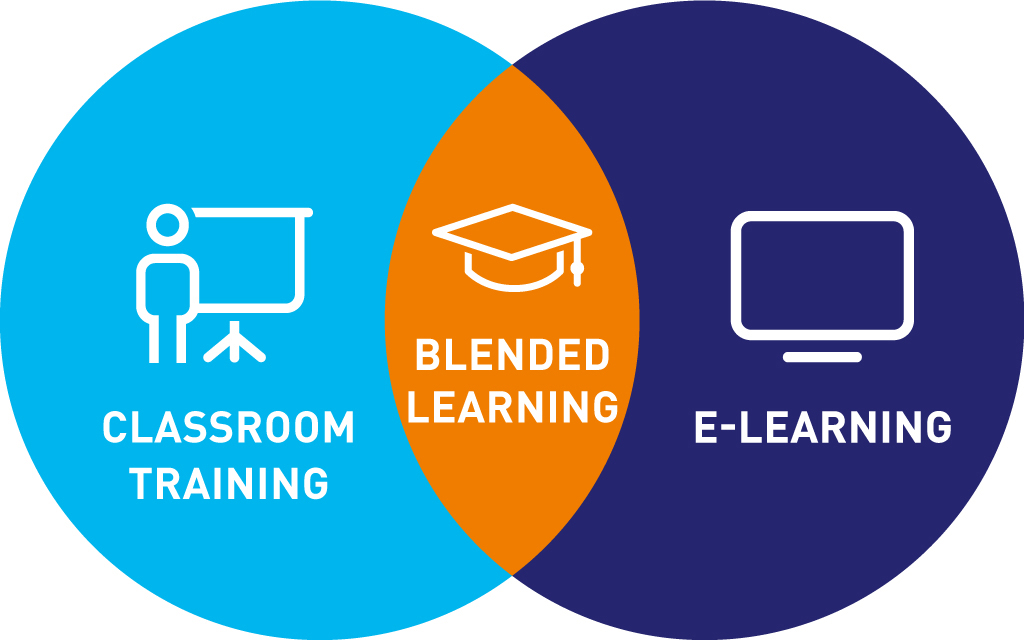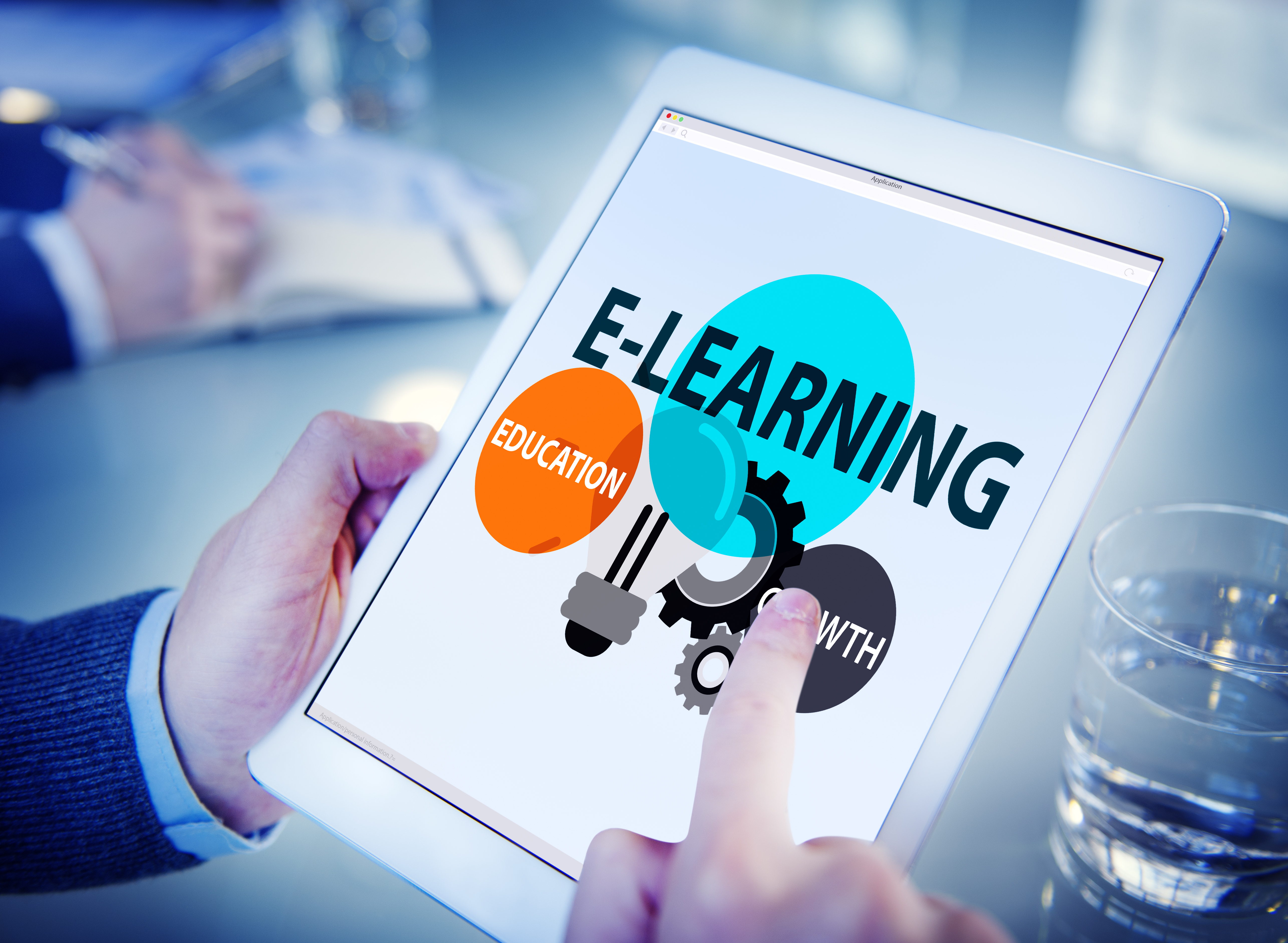Access training (south West) Ltd
BLENDED LEARNING vs E-LEARNING vs FACE TO FACE LEARNING
What is Blended Learning?

Blended learning courses typically offer a series of self-study and guided learning activities, and often combine both online and offline learning.
In a blended learning course, learners make their way through learning activities which might include but are not limited to: reading about new concepts, watching video demonstrations or animated process overviews, engaging in single and group discussions, and practicing new skills.
The Components of a Blended Learning Course
Learners might engage in these learning activities both in more traditional face-to-face sessions and via eLearning and other digital learning components, so a blend might include:
 eLearning
eLearning
 face-to-face workshops
face-to-face workshops
 scenarios (digital or offline)
scenarios (digital or offline)
 workbooks (digital or offline)
workbooks (digital or offline)
 podcasts
podcasts
 simulators
simulators
 online forums
online forums
A well designed blended learning program combines the benefits offered by face-to-face approaches, with the advantages offered by digital learning approaches.
Let’s take a closer look at some of those benefits and advantages.
The Strengths of Face-To-Face Training

Face-to-face training, with its emphasis on human interaction, offers some clear advantages:
 It allows learners to raise queries in the moment
It allows learners to raise queries in the moment
 It enables learners to spend time with peers
It enables learners to spend time with peers
 Learners can actively practice, collaborate or even compete with guidance from an experienced tutor
Learners can actively practice, collaborate or even compete with guidance from an experienced tutor
However, one significant downside to face-to-face only learning is the cost of delivering it: venue booking, the costs for a trainer, food and drink if provided, and the need for organization of all of this by a person or persons administering the course. Perhaps because of the above, classroom learning tends to consist of occasional, one-off events, so days can be long, with too much for learners to take in and retain.
To make matters worse, where learners don’t use their new skills for a while, they are likely to forget them before being able to apply them. This is known as the Forgetting Curve, drawing from the work of Dr Hermann Ebbinghaus. Learners often come away from workshops with notes, but in many cases need more guidance and support to help maintain and apply their learning.
The Benefits of Introducing eLearning

Introducing eLearning brings a number of benefits:
 Efficient information delivery – in a well-designed blend, initial underpinning information can be more efficiently delivered via eLearning, which can incorporate highly engaging formats such as video and animation.
Efficient information delivery – in a well-designed blend, initial underpinning information can be more efficiently delivered via eLearning, which can incorporate highly engaging formats such as video and animation.
 That underpinning information can be delivered in a way which is ‘bite-sized’ (also known as microlearning) which makes it easier for people to fit it into their working day.
That underpinning information can be delivered in a way which is ‘bite-sized’ (also known as microlearning) which makes it easier for people to fit it into their working day.
 Learners can move at their own pace, rather than the pace of the group and they can decide when and where to engage with online activities.
But learners are also given a structure, pathway and some deadlines, so they aren’t left to plan and design their own learning.
Learners can move at their own pace, rather than the pace of the group and they can decide when and where to engage with online activities.
But learners are also given a structure, pathway and some deadlines, so they aren’t left to plan and design their own learning.
 Rewinding and repeating content can clarify anything not immediately understood, which also helps to combat the Forgetting Curve.
Rewinding and repeating content can clarify anything not immediately understood, which also helps to combat the Forgetting Curve.
 Increased interaction – online forums and virtual classrooms allow for more interaction between people who can’t meet face-to-face easily and often
Increased interaction – online forums and virtual classrooms allow for more interaction between people who can’t meet face-to-face easily and often
 New technologies and approaches – new ways of interacting, such as augmented reality (AR), virtual reality (VR) and learning games, can allow learners to gain experience and practice in new ways. A good example of this is practicing for rare situations and events in realistic environments.
New technologies and approaches – new ways of interacting, such as augmented reality (AR), virtual reality (VR) and learning games, can allow learners to gain experience and practice in new ways. A good example of this is practicing for rare situations and events in realistic environments.
Blended Learning Combines the Benefits of eLearning and Face-To-Face Training
When it comes to sustained learning programs—those that take place over time—a blended learning strategy can offer several benefits:
 Learning that is both cost-effective and more effective at reaching larger numbers of learners in remote areas.
Learning that is both cost-effective and more effective at reaching larger numbers of learners in remote areas.
 Learning that supports structured practice little and often over time.
Learning that supports structured practice little and often over time.
 A balance between combining a clear structure and pathway with flexibility about where and when to engage with many of the individual learning activities.
A balance between combining a clear structure and pathway with flexibility about where and when to engage with many of the individual learning activities.
 Interaction with subject matter experts (SMEs): Asking questions of experts or discussing new learning with other learners is often a key factor in getting to grips with a subject.
Interaction with subject matter experts (SMEs): Asking questions of experts or discussing new learning with other learners is often a key factor in getting to grips with a subject.
 Increased interaction with peers, allowing people to learn via collaboration and discussion.
Increased interaction with peers, allowing people to learn via collaboration and discussion.

 eLearning
eLearning face-to-face workshops
face-to-face workshops scenarios (digital or offline)
scenarios (digital or offline) workbooks (digital or offline)
workbooks (digital or offline) podcasts
podcasts simulators
simulators online forums
online forums
 It allows learners to raise queries in the moment
It allows learners to raise queries in the moment It enables learners to spend time with peers
It enables learners to spend time with peers Learners can actively practice, collaborate or even compete with guidance from an experienced tutor
Learners can actively practice, collaborate or even compete with guidance from an experienced tutor
 Efficient information delivery – in a well-designed blend, initial underpinning information can be more efficiently delivered via eLearning, which can incorporate highly engaging formats such as video and animation.
Efficient information delivery – in a well-designed blend, initial underpinning information can be more efficiently delivered via eLearning, which can incorporate highly engaging formats such as video and animation. That underpinning information can be delivered in a way which is ‘bite-sized’ (also known as microlearning) which makes it easier for people to fit it into their working day.
That underpinning information can be delivered in a way which is ‘bite-sized’ (also known as microlearning) which makes it easier for people to fit it into their working day. Learners can move at their own pace, rather than the pace of the group and they can decide when and where to engage with online activities.
But learners are also given a structure, pathway and some deadlines, so they aren’t left to plan and design their own learning.
Learners can move at their own pace, rather than the pace of the group and they can decide when and where to engage with online activities.
But learners are also given a structure, pathway and some deadlines, so they aren’t left to plan and design their own learning. Rewinding and repeating content can clarify anything not immediately understood, which also helps to combat the Forgetting Curve.
Rewinding and repeating content can clarify anything not immediately understood, which also helps to combat the Forgetting Curve. Increased interaction – online forums and virtual classrooms allow for more interaction between people who can’t meet face-to-face easily and often
Increased interaction – online forums and virtual classrooms allow for more interaction between people who can’t meet face-to-face easily and often New technologies and approaches – new ways of interacting, such as augmented reality (AR), virtual reality (VR) and learning games, can allow learners to gain experience and practice in new ways. A good example of this is practicing for rare situations and events in realistic environments.
New technologies and approaches – new ways of interacting, such as augmented reality (AR), virtual reality (VR) and learning games, can allow learners to gain experience and practice in new ways. A good example of this is practicing for rare situations and events in realistic environments. Learning that is both cost-effective and more effective at reaching larger numbers of learners in remote areas.
Learning that is both cost-effective and more effective at reaching larger numbers of learners in remote areas. Learning that supports structured practice little and often over time.
Learning that supports structured practice little and often over time. A balance between combining a clear structure and pathway with flexibility about where and when to engage with many of the individual learning activities.
A balance between combining a clear structure and pathway with flexibility about where and when to engage with many of the individual learning activities. Interaction with subject matter experts (SMEs): Asking questions of experts or discussing new learning with other learners is often a key factor in getting to grips with a subject.
Interaction with subject matter experts (SMEs): Asking questions of experts or discussing new learning with other learners is often a key factor in getting to grips with a subject. Increased interaction with peers, allowing people to learn via collaboration and discussion.
Increased interaction with peers, allowing people to learn via collaboration and discussion.